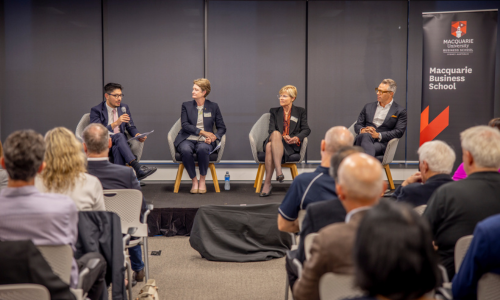View from the top: a look at the modern boardroom
Diverse thinking, asking questions and starting with strategy were listed as keys to a successful board at our recent View from the Top event.

Despite a wet night on 4 April, the City Campus was filled with alumni from our MBA and Master of Applied Finance, current students in those programs and industry members interested in an insightful exploration of the issues influencing leadership and decisions within boardrooms.
Joining them in the room was a distinguished panel of industry experts – all Macquarie University Business School alumni – Catherine Livingstone AC FAICD, Chancellor of the University of Technology Sydney and Former Chair of the Commonwealth Bank of Australia; Lyn Cobley, Non-Executive Director of the Commonwealth Bank of Australia and former CEO, Institutional Bank, Westpac Banking Corporation; and Jason Johnson, Founder and CEO of Johnson Partners and Founder and Co-convenor of the Asian-Australian Leadership Awards. With Professor Eric Knight leading the conversation, the panel discussed how boards confront the issues of business and the role of diversity in enhancing decision-making. The conversation weaved itself through various themes, but the points on how to stay strategic and encourage diversity at the top resonated the most with attendees.
Start with strategy
Not everything goes to plan all the time, but a successful board responds quickly and effectively to uncertainty by managing risk and utilising the resources of the company.
“In the experience I have had,” Lyn explained, “committees are very helpful. They allow you to dial up and dial down the focus on issues as they appear.”
Committees can be used to do the detailed work, allowing boards to listen to recommendations, challenge decisions and be confident in their actions.
This also allows boards to focus on strategy to ensure the organisation is not swayed from their strategic direction because of issues or onerous compliance work.
“When I do an agenda, it’s divided into thirds and the first third is strategy, the second third is business performance, and the last third is compliance – not because compliance is not important but if you start with compliance, you will never get to strategy,” said Catherine. “You really have to discipline yourself to start with strategy.”
Ask the right questions, and don’t settle for the first answer
Another interesting insight was the role of asking the right questions, asking questions often and validating the answers with more questions.
Catherine shared the wisdom of her Macquarie University honours Professor who instilled in her and other students that asking for the second right answer was a way to confirm the best solution.
“The point is that you don’t jump to conclusions and don’t go for the answer, just keep asking the questions,” Catherine said. “This wisdom has stayed with me for the rest of my life.”
Another top tip for business leaders is to follow the ‘what, so what, then what’ rubric to keep board papers clear and concise.
Be friendly but not friends
The panel also discussed the pivotal relationship between the Chair, CEO and management and one key point was for these groups to “be friendly but not friends”.
“You have to allow management to feel supported and challenged,” said Catherine, highlighting the point that these groups should work together with respect and rigour.
Diversity of thinking is key
Diversity was a theme that ran through the whole conversation and Jason Johnson helped paint a picture of diversity in Australia’s top 300 companies. He said there is not much diversity in this group, citing ethnicity, gender, sexuality and First Nations representation.
But turning the conversation to practical ways to increase diversity, Jason said, “I was involved in a report released a couple of weeks ago called the Green Shoots Report, which Deloitte co-authored with the 30 per cent plus club. And a number of authors there were able to evidence a number of situations, anecdotal at this point, rather than systemic, towards a trend of greater diversity on boards.”
“There’s greater opportunity to bring more diversity of thought experience and cultural diversity, and we are seeing, increasingly, a real demand for people who are digitally fluent, able to navigate AI and the broader emerging technology wave, and people who understand the requirements of decarbonisation to ease the energy transition,” Jason said.
Catherine agreed, “We don’t just focus on what looks like diversity, because it’s diversity of thinking we actually want, and the ability to ask questions from different angles.”
The panel also agreed that diversity in boardrooms begins with ensuring diversity within middle management and business leaders need to encourage and support diverse groups through this experience if they want them to truly succeed in the top jobs.
About the event series
This series of exclusive events will run throughout the year, with a focus on being a forum for ideas and networking for current post-experience postgraduate students, alumni and industry professionals. Each event spotlights an important business topic with commentary from high-calibre guest speakers and Macquarie Business School academics. We look forward to the next event in July.